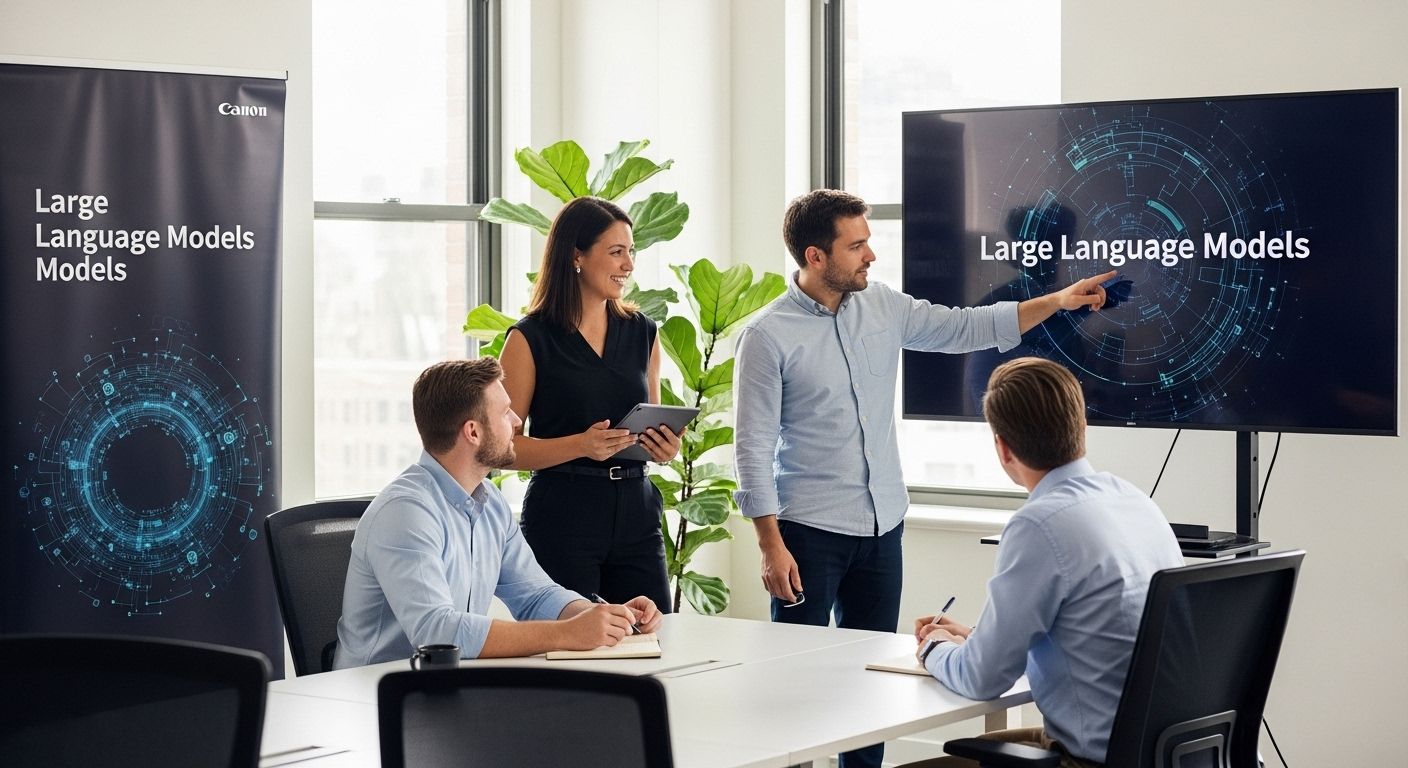
Introduction to Large Language Models - Key Concepts and Applications
Large Language Models are powering the smartest chatbots and virtual assistants you use today and they can process huge amounts of text and generate responses that seem almost human. Now here is the wild part. Some of these models have been trained on data sets containing over a trillion words. You might expect that this mountain of information would just lead to mindless repetition but instead these models unlock creative language, solve real-world problems, and drive real change across industries from healthcare to finance.
Table of Contents
- Table of Contents
- Quick Summary
- Understanding How Large Language Models Work
- Practical Applications of Large Language Models in AI
- Essential Skills for Working with Large Language Models
- Frequently Asked Questions
- Master Large Language Models with Practical AI Engineering
Quick Summary
| Takeaway | Explanation |
|---|---|
| Large Language Models revolutionize AI communication | LLMs transform machine understanding and generation of human language, enabling advanced interactions. |
| LLMs require sophisticated technical skills | Mastery of machine learning concepts, programming, and ethical considerations are crucial for effective use of LLMs. |
| Ethical AI development is essential | Professionals must address bias, interpretability, and responsible use when deploying LLMs in real-world applications. |
| Continuous learning is vital in AI | The rapidly evolving nature of LLM technology necessitates ongoing education and adaptability for success in the field. |
| LLMs have diverse industry applications | They are transforming sectors like healthcare and finance through enhanced data analysis, customer interactions, and problem-solving capabilities. |
Understanding How Large Language Models Work
Large Language Models (LLMs) represent a groundbreaking approach to artificial intelligence that transforms how machines understand and generate human language. These sophisticated neural network architectures have revolutionized natural language processing by developing unprecedented capabilities in text generation, comprehension, and complex reasoning.
The Fundamental Architecture of Language Models
At their core, LLMs function through a complex mechanism of pattern recognition and probabilistic prediction. According to researchers at MIT, these models often employ surprisingly simple linear functions to retrieve and decode stored knowledge.
The training process involves exposing the model to massive text datasets, allowing it to learn intricate linguistic patterns, semantic relationships, and contextual nuances. Unlike traditional programming approaches, LLMs develop an understanding of language through statistical analysis, identifying complex connections between words, phrases, and entire paragraphs.
Knowledge Representation and Generation Mechanisms
LLMs do not merely memorize information but create sophisticated internal representations of language. As explained by the Center for Security and Emerging Technology, these models learn by being exposed to extensive text data, enabling them to generate contextually relevant responses across diverse domains.
The models achieve this through multiple neural network layers that process information hierarchically. Each layer extracts increasingly abstract features from input text, allowing the model to understand context, interpret meaning, and generate human-like responses. This multi-layered approach enables LLMs to handle complex linguistic tasks such as translation, summarization, question answering, and even creative writing.
The probabilistic nature of these models means they generate text by predicting the most likely sequence of words based on their training data. This approach allows for flexibility and creativity while maintaining coherence and relevance. However, it also introduces potential challenges like generating biased or inconsistent outputs, highlighting the critical importance of robust training data and sophisticated filtering mechanisms.
Understanding LLMs requires recognizing them not as static databases but as dynamic systems capable of learning, adapting, and generating novel linguistic content. Their potential extends far beyond simple text generation, promising transformative applications in fields ranging from scientific research to personalized communication technologies.
Practical Applications of Large Language Models in AI
Large Language Models (LLMs) have emerged as transformative technologies across multiple industries, revolutionizing how businesses and researchers approach complex computational challenges. Their ability to understand, generate, and process human-like text has opened unprecedented opportunities for innovation and problem-solving.
Revolutionizing Industry-Specific Solutions
In healthcare, LLMs are dramatically changing patient care and medical research. Learn more about AI system optimization techniques that enable these advanced applications. According to research from PubMed, these models assist in diagnosing diseases, personalizing treatment plans, and managing complex patient data with remarkable precision. They can analyze medical literature, synthesize research findings, and even help predict potential health risks by identifying patterns in vast medical datasets.
In the financial sector, LLMs are transforming risk management and customer interactions. Researchers from ArXiv highlight their potential in fraud detection, customer service automation, and sophisticated financial analysis. These models can process complex financial documents, generate comprehensive reports, and provide nuanced insights that traditional computational methods cannot achieve.
Robotics and Advanced Interaction Technologies
The integration of LLMs in robotics represents a groundbreaking frontier of artificial intelligence. Recent research from ArXiv demonstrates how these models facilitate enhanced human-robot interaction by enabling more natural language processing and understanding. Robots equipped with advanced language models can now interpret complex instructions, adapt to contextual nuances, and provide more intuitive responses across various operational environments.
These models are not merely translating commands but are developing sophisticated capabilities in robot control, perception, and autonomous decision-making. By processing and generating natural language, LLMs help robots understand complex scenarios, plan intricate tasks, and interact more seamlessly with human operators.
The practical applications of Large Language Models extend far beyond traditional computational boundaries. They represent a paradigm shift in how machines understand and interact with human communication, offering unprecedented opportunities for innovation across healthcare, finance, robotics, and numerous other domains. As these technologies continue to evolve, we can anticipate even more sophisticated and transformative applications that will reshape our understanding of artificial intelligence and human-machine interaction.
To help readers understand the real-world impact of Large Language Models, here is a summary of their transformative applications in key industries, as discussed in the article.
| Industry | Application Areas | Example Contributions |
|---|---|---|
| Healthcare | Disease diagnosis, personalized treatment, research | Synthesizing medical literature, identifying health risks, managing complex patient data |
| Finance | Risk management, customer interaction, analysis | Fraud detection, automated customer service, comprehensive financial reporting |
| Robotics | Human-robot interaction, task planning | Understanding natural language instructions, adaptive decision-making, improved robot control |
Essential Skills for Working with Large Language Models
Mastering Large Language Models (LLMs) requires a sophisticated blend of technical expertise, critical thinking, and adaptive problem-solving skills. Professionals seeking to excel in this emerging field must develop a comprehensive skill set that goes beyond traditional programming approaches.
For those seeking to work with Large Language Models, the following table summarizes essential technical and professional skills, as outlined in the article.
| Skill Area | Key Skills/Considerations |
|---|---|
| Technical Proficiency | Python, TensorFlow, PyTorch, data preprocessing, model fine-tuning, prompt optimization |
| Model Understanding | Interpreting outputs, transfer learning, few-shot learning, configuring architectures |
| Ethical AI Development | Bias detection, interpretability, responsible deployment |
| Continuous Learning | Staying updated with research, analyzing model behaviors, innovative problem-solving |
Technical Proficiency and Model Understanding
Successful work with LLMs demands a deep understanding of machine learning principles and neural network architectures. Learn more about advanced AI system techniques for effective model management. According to the US Department of Energy’s Office of Scientific and Technical Information, key technical skills include data annotation, prompt optimization, and model fine-tuning. Professionals must develop the ability to interpret model outputs critically, understanding both the capabilities and limitations of these complex systems.
Programming skills in languages like Python are crucial, with expertise in libraries such as TensorFlow and PyTorch being particularly valuable. Professionals should be comfortable with data preprocessing, model configuration, and implementing advanced techniques like transfer learning and few-shot learning. This requires a nuanced understanding of how different model architectures process and generate language.
Ethical Considerations and Responsible AI Development
Working with Large Language Models extends far beyond technical implementation. Professionals must develop a sophisticated approach to ethical AI development, understanding the potential biases and societal implications of these powerful technologies. This involves critical skills in:
- Bias Detection: Identifying and mitigating potential prejudices in training data and model outputs
- Interpretability: Developing techniques to explain model decision-making processes
- Responsible Deployment: Ensuring AI systems are used in ways that protect individual privacy and promote fairness
Continuous Learning and Adaptive Problem-Solving
The field of Large Language Models is rapidly evolving, demanding a commitment to continuous learning and adaptability. Professionals must stay current with the latest research, emerging technologies, and best practices. This requires developing skills in:
- Quickly understanding and implementing new model architectures
- Analyzing complex model behaviors
- Developing innovative solutions to emerging challenges
Successful LLM professionals must think beyond traditional computational approaches. They need to combine technical expertise with creative problem-solving, understanding how these models can be applied across diverse domains. This involves developing a holistic view of AI technology that balances technical capabilities with ethical considerations and practical applications.
Ultimately, working with Large Language Models is about more than technical skills. It requires a dynamic approach that combines deep technical knowledge, ethical awareness, and the ability to continuously adapt to a rapidly changing technological landscape. Professionals who can master this complex skill set will be at the forefront of one of the most exciting and transformative technologies of our time.
Frequently Asked Questions
What are Large Language Models (LLMs)?
Large Language Models are advanced AI systems designed to understand, generate, and process human language. They are trained on massive datasets, allowing them to produce human-like responses and perform complex language tasks.
How do Large Language Models work?
LLMs work through transformer architecture, utilizing pattern recognition and probabilistic prediction to generate text. They analyze input data in a hierarchical manner, capturing linguistic patterns, semantics, and context.
What are the applications of Large Language Models in various industries?
LLMs have diverse applications across industries, including healthcare for diagnosing diseases, finance for risk management and customer service, and robotics for enhancing human-robot interactions through natural language understanding.
What skills are necessary for working with Large Language Models?
Essential skills include technical proficiency in programming languages like Python, understanding machine learning principles, ethical AI development practices, and a commitment to continuous learning in a rapidly evolving field.
Master Large Language Models with Practical AI Engineering
Want to learn exactly how to build and deploy production-ready Large Language Models that solve real business problems? Join the AI Engineering community where I share detailed implementation guides, optimization techniques, and work directly with engineers building transformer-based systems at scale.
Inside the community, you’ll find practical LLM deployment strategies that actually work for growing companies, plus direct access to ask questions about model fine-tuning, prompt engineering, and production optimization challenges.
